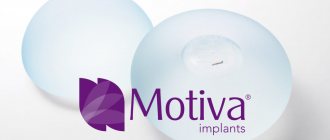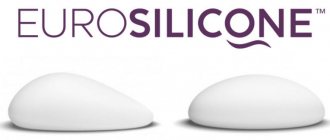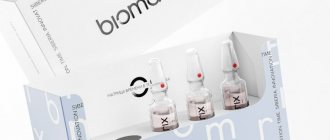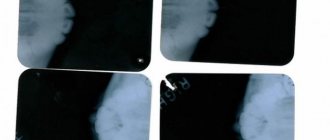In this article we will analyze in detail POLYTECH breast implants (Polytech). What shapes, profiles and surfaces do they have? What kind of guarantee does the manufacturer provide, how is preparation for the operation carried out and how it is done. We’ll also find out how much they cost, as well as the opinions of plastic surgeons and patient reviews.
Breast implants Polytech
What problems do POLYTECH breast implants solve?
Surgical interventions performed using POLYTECH breast implants help:
- increase the size with a small volume of mammary glands;
- get rid of ptosis that cannot be corrected by non-surgical methods;
- restore breast shape and size after mastectomy used for cancer therapy.
Most often, implants are used for breast augmentation.
Types of POLYTECH breast implants
Implants vary in surface structure, shape and profile.
Surface
There are several types of surfaces:
- Micro-textured MESMO sensitive provides reliable fixation, preventing displacement. The implants are filled with silicone gel, which perfectly holds its shape and quickly restores it after compression. The products are supplied in special sterile packaging. Implants with such a surface reduce the risk of seroma and capsular contracture.
- Micro-textured POLYtxt prevents the formation of keloid tissue, which often forms around a foreign body after surgery. This surface reduces the risk of capsular contracture.
- Micropolyurethane Microthane designed specifically to prevent complications. This surface promotes reliable fixation of the implant and also reduces the risk of capsular contracture. The shell is made of special polyurethane foam, which is maximally compatible with body tissues.
Form
Implants also differ in shape, they can be:
- Dome-shaped with a round MEME base. Available with three types of shells - micro- and macro-textured, as well as with a surface made of polyurethane foam. Filling with cohesive gel ensures that the implant feels natural to the touch. The material quickly regains its shape.
- Anatomical with round base REPLICON. This form allows you to achieve the most natural results. In this case, the shape of the breasts of an adult woman is recreated. The bust looks as organic as possible.
- Anatomical with shortened OPTICON base. This form is designed specifically for overweight women. Such shortened implants enlarge the bust, making it attractive, without a hint of silicone.
- Anatomical with an oblong base OPTIMAM. Such implants are intended for athletic and slender women. Even with increased physical activity, they do not cause discomfort.
POLYTECH implants come in different shapes, each of which is selected individually
The company also produces an additional variety - DiagonGel® 4Two two-gel implants. They are filled with a special soft substance EasyFitGel™, thanks to which the silicone fits better to the chest and helps maintain the natural shape of the chest during various movements. Another gel, ShaparGel™, has a denser and more consistent texture, resulting in a push-up effect and anatomically correct placement of the nipple.
POLYTECH DiagonGel® 4Two double-gel implants help maintain the natural shape of the bust
Profile
The profile is selected depending on the physiological characteristics of the woman. Kinds:
- Low - characterized by a flat shape, is the smallest. Most often used for narrow chests and short stature.
- The middle one is larger than the previous one and has an anatomical shape. This option is used most often. Not used for significant prolapse of the mammary glands.
- High - indicated for severe ptosis in women with a narrow chest. Such implants allow you to tighten the mammary glands without additional skin removal due to the large volume.
- Extra high - this option is designed for maximum breast enlargement. The volume of implants in this case is the largest.
The profile of the implants is selected depending on the physiological characteristics of the patient
Brands producing compression implants
The dental products market offers implants with compression threads of the following brands:
- ROOTT (Switzerland);
- Nobel (Sweden);
- Straumann (Switzerland);
- Osstem (South Korea);
- Alpha Bio (Israel);
- and etc.
Each manufacturer conducts a lot of unique research, trying to study all possible aspects of implantation, successful and not so successful, to create an effective product. A lot of money and time are invested in this. New and improved Compressive products are released periodically.
For example, RUTT compression implants are represented in a wide range. Each type of product has a different abutment angle, pin length, type of notches, neck length, and grinding method. These are factors influencing the success of the operation. Combining different systems allows you to securely fix any prosthesis with minimal additional manipulation costs. In addition, RUTT compression implants are also available in multi-unit units, which allows them to be optimally used for All-on-4, All-on-6 prosthetics, and for toothless jaws.
Comparison with other popular breast implants
| Name | Shell | Filling | Peculiarities |
| POLYTECH | The durable shell consists of 8 elastic layers. | Highly adhesive silicone gel |
|
| Arion | Ultra-thin silicone elastomer | Carboxymethylcellulose and saline solution |
|
| Eurosilicone | "PARAGEL" casing production technology | Cohesive gel |
|
| Mentor | Siltex technology | Cohesive gel |
|
What are compression implants - features
Implants replace the base of the tooth, perform all its functions, and support crowns and bridges. Consist of a metal pin and abutment. To make the implant, biocompatible materials are used that will allow the body not to reject it, but allow it to take root.
Compression implants have a special thread shape, which, already during the implantation process, compacts and compresses the bone tissue, forming close contact with the titanium surface of the artificial root. This ensures stable fixation and rapid osseointegration. The thread has one more feature - it is self-tapping. That is, it preserves the fabric as much as possible, does not push it out, but collects it around itself. An extremely important fact in atrophy.
The installation is carried out in a minimally invasive way, by puncturing the gums, then, as usual, the “patch method” is used, with cutting the tissue and then suturing it. For the next stage of prosthetics, you need to wait until the wound heals in the classic version. But compression dental implantation involves immediate loading, a one-step protocol. Puncture, implantation, impression taking, attachment of an adaptive prosthesis.
It should be noted that compression implants are not recommended for single restorations. Their area of application is prosthetics for the loss of several teeth in a row.
Manufacturer's warranty and service life
The manufacturer provides a lifetime warranty on its products. All materials have a European certificate of conformity. If the implant shell ruptures, a free replacement with a new one is provided. The service life is not limited, however, if within 10 years after the operation the material is displaced or a contracture is formed, then in this case repeated free intervention is provided in order to eliminate the consequences. Implant replacement is also provided.
The Implants of Excellence warranty program confirms the quality of the products. Documentation is provided to each client.
Laboratory tests
Laboratory studies revealed that the use of a micropolyurethane shell helps reduce the risk of postoperative complications. In this case, the probability of implant displacement is reduced to zero. After its installation, fibroblasts grow into the polyurethane foam matrix, which prevents the formation of capsular contracture. This was proven through a study in which 1257 patients were observed for 18 years. During this period, complications occurred in only 1% of women.
Advantages and disadvantages
Advantages of compression dental implants:
- stable fixation
- use for moderate tissue atrophy
- atraumatic implantation
- rapid osseointegration
- suitable for single-stage protocol with immediate loading
Flaws:
- not used for single restorations
- if there is a large loss of tissue, the tissue is not suitable (only basal implantation or osteoplasty)
Implantation is not performed during pregnancy, breastfeeding and under 18 years of age.
Preparing for surgery
Before surgery, preparation is important, including determining the shape and size of implants for a particular patient. At this stage it is also necessary:
- do an ECG;
- take a general blood and urine test;
- be tested for syphilis and HIV infection;
- donate blood for clotting;
- undergo fluorography.
The first step is to choose the volume and shape of the implants; a plastic surgeon will help with this.
When preparing, the psychological component is important. You need to get bad thoughts out of your head and tune in to a good result. You should also stop taking medications that affect blood clotting for 2 weeks. These include: NSAIDs, glucocorticosteroids, etc. It is recommended to give up alcohol and smoking. Such bad habits can slow down tissue healing.
Immediately before the operation (12 hours before) you need to refuse food and water. It is recommended to prepare all the necessary things, including personal hygiene items. Increased physical activity and stress should also be avoided before the intervention.
It is important to inform your doctor about taking any medications at least 2 weeks before surgery. Especially if these are hormonal contraceptives.
How is the operation performed?
Implants are installed through the following approaches:
- submammary - through the inframammary fold;
- periareolar - through the areola;
- axillary - through the armpit.
Which method is preferable in a particular case is determined depending on the anatomical features of the breast structure.
The following describes an operation in which the material is placed submammary.
Stages:
- The surgical field is marked. Then the patient is given anesthesia, and the intervention site is limited with sterile sheets.
- Then an incision is made.
- The next step is to form a pocket. During the intervention, coagulation of blood vessels occurs to stop bleeding. A special electric scalpel is used to separate tissues.
- An implant is installed in the formed pocket. It is then carefully distributed under the muscle or mammary gland.
- Finally, a drainage is installed to drain the wound fluid, and sutures are applied in parallel.
Recovery period
Recovery may take 2-3 months. It is important to take all medications that were prescribed. Most often, painkillers and antibiotics are recommended during the postoperative period to prevent the occurrence of infectious complications. Discharge is usually carried out within 1-3 days.
After the intervention, the following rules must be observed:
- wear compression garments for a month to promote tissue healing and reduce pain;
- give up alcohol and smoking for at least 8-12 weeks;
- do not take a bath for 1 month, it is advisable to wash only in a warm shower, without affecting the area of intervention;
- Do not treat the seams yourself with anything, so as not to provoke inflammation;
- Avoid physical activity for the first three months, including lifting heavy objects.
Compression garments reduce pain and promote rapid tissue healing
Pain after surgery can last from 2 days to 2-3 weeks. It all depends on the individual characteristics of the body.
Prosthetic options
In dental implantology, there are the following types of prosthetics.
Classic two-stage implantation with delayed loading of the prosthesis:
- an incision is made and a flap of gum is detached;
- implantation of a titanium rod;
- suturing, suturing;
- time is given for the implant to heal (about 3-6 months);
- an impression is made, a prosthesis is made;
- fitting, fitting and fixation of the prosthesis with dental cement.
One-stage implantation with immediate loading of the prosthesis:
- gum puncture
- implantation of a monoblock implant
- taking impressions
- installation of a prosthesis
A one-step protocol is possible if the gums and teeth are in good condition and there are no inflammatory processes in the body.
Prosthetics with compression implants are usually permanent. For removable, conditionally removable orthopedic structures, other types of implants are used.
Photos before and after surgery
Photos before and after breast augmentation with POLYTECH implants (volume 275 ml, round) with access under the muscle
Photos before and after breast augmentation with POLYTECH implants (Mesmo Sensitive, volume 395 ml) with installation under the pectoralis major muscle
Photos before and after breast augmentation with POLYTECH implants (anatomical, volume 350 ml), incision in the submammary fold, placed under the muscle
Photos before and after breast augmentation with POLYTECH implants (Mesmo, volume 315 ml) through an incision in the areola area
Photos before and after breast augmentation with POLYTECH Mesmo implants through axillary access
Cost of POLYTECH implants
The price of POLYTECH implants varies depending on the model and starts from 90 thousand rubles. This does not include the cost of the operation.
Price with surgery in Moscow
| Clinic name | Cost, thousand rubles. |
| Celine | from 300 |
| Frau Clinic | from 350 |
| Sharm Gold | from 400 |
| Doctor plastic | from 370 |
| Bios | from 310 |
Price with surgery in St. Petersburg
| Clinic name | Price, thousand rubles |
| Mediler | from 250 |
| Center for Reconstructive, Restorative and Plastic Surgery | from 200 |
| Breast Health | from 280 |
| Mediler | from 200 |
| GrandMed | from 250 |
Price
The cost of compression dental implantation consists of the cost of diagnosis, the preliminary stage, including treatment of caries, removal of tartar, removal (if indicated), implantation technique, prosthetics and the selected type of implant and prosthesis.
The implantation procedure itself is expensive, but if you know that it is for life, while metabolic processes in the bone tissue continue, it does not atrophy, the correct chewing load is maintained, the face is transformed, and the quality of life is justified, then the price is justified.
And since compression implants are used for bridges, and not for single crowns, the price depends on the number of implanted roots. For example, for one jaw with complete edentia, one-stage implantation with a combination of 6 - 12 implants and an adaptive prosthesis on a metal frame, the cost at the RUTT clinic will be 265,000 rubles, for a titanium one - 295,000 rubles. If this is a segment of three teeth, then you need to calculate from 135,000 rubles, from 5 - from 200,000 rubles. on average for Moscow.
Popular questions
How many years are POLYTECH silicone implants installed?
Replacement is carried out only according to indications, the main of which are: the occurrence of pain in the mammary glands, the appearance of capsular contracture, sagging breasts, etc. If everything is in order, then repeated intervention is not necessary.
Which POLYTECH shape is better: round or anatomical (teardrop-shaped)?
It all depends on the woman’s desire, but it is the anatomical options that are popular, which give the breasts a natural shape.
After surgery to install POLYTECH implants, do your breasts feel any different to the touch?
When surgery is performed correctly, the mammary glands look natural and feel the same as before the augmentation. The only thing that should be noticed is that the breasts become more elastic. In a certain position of the body, if the woman is thin, the implant can be felt, but this is possible in rare cases.
How many sizes can you enlarge your breasts with POLYTECH at one time?
It all depends on the woman’s physiology. But it is not recommended to enlarge your breasts by more than 3 sizes at a time.
Opinions of plastic surgeons
The doctor confirms that good aesthetic results can be achieved with POLYTECH.
The surgeon emphasizes that if a woman has thin skin, then it is better to use double-gel implants.
The doctor notes that POLYTECH has a wide range of models.
Patient reviews
The patient notes that after the intervention, nipple sensitivity may disappear, but this is a temporary phenomenon.
Another girl in her review points out that the risk that the implant will not take root is minimal.
And this one says that the material is very soft to the touch.
Where to go for installation of compression implants
Compression implantation is combined with basal and others in a one-stage protocol. Compression thread allows these implants to be used in express implantation - a quick way to forget about dental problems. But you should contact trusted medical centers and qualified specialists. Accurate diagnosis and the optimally effective chosen treatment regimen play an important role.
Various dental clinics can offer services for installing compression implants. We have listed some of them in the table.
| Dentistry | Website | Address |
| ROOT Center | https://dentalroott.ru |
|
| Implant Ru | https://www.implant.ru |
|
| Smile-esthet | https://smile-estet.ru |
|
| Unident | https://www.6750000.ru |
|
| Center Family Dentistry | https://family-dental.ru |
|
Other jobs











